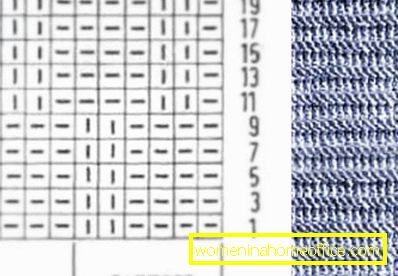Relief patterns knitting needles
After the beginner needlewomen learns the basic variants of knitting, the garter and the rubber bottle, they want to try something new, a little more complicated, but just as fast to learn and bring a zest to the product. Relief patterns spokes perfectly fit: among their variety it is easy to choose several options, work them out and combine with each other, getting new patterns on the surface.
Relief patterns knitting needles: a scheme with a description
The simplest pattern of knitting needles for beginners is a raised column that runs continuously throughout the entire product and can become the basis for any thing: for example, a scarf. Moreover, it can consist of both the usual alternation of purl and facial loops, as well as of more complex elements — nakida, broaches, etc.

The classic column is rapport for 6 loops, of which 4 are knitted with purl, 2 - with face loops. On the next odd row, the pattern repeats and duplicates every odd row up to the 9th. On the 11th row, the extreme loop is knitted with a purl, then 2 loops - with facial loops, the next 3 loops are again purlled. Also, you need to duplicate the scheme in odd rows up to the 19th.
The same column can be turned into an almost classical cell, moreover, it will be no more difficult in terms of its performance: rapport for 7 loops, from the side of the edge 2 extra, which make up half of the pattern. The first one is removed, the second one is carried out in a purl, the next 5 loops are facial, then again the second purl. On the next odd row, everything repeats, and the 5th row begins with the loop removed, then the front one is knitted, the other 5 are pursed and the second one. 3 more odd rows are performed in the same way: from the 13th row the first one is repeated. On even rows, all the loops are knitted in purses.

Want a more pronounced column of cells? The report on 11 loops, the first row is completely facial, on the 3rd row there are loops 3-10 purl, the rest are facial. The fifth row completely repeats the third, on the seventh row only 3-4 and 9-10 loops will be purl, the rest are performed by the front ones. The 7th and 9th rows are identical to him, and the 11th repeats the 3-5 rows, the 13th duplicates the 1st. All even match with simple purl loops.
In the category of more complex options, performed on the needles - the pattern "leaves", which can be either simple relief or openwork. Attractive, of course, looks the latest version. This mating is good as an edge, because only on the 1st side it connects to the general canvas, and on the 2nd side it has a figured edge.

To make a “leaf” pattern with knitting needles, it is necessary to collect 15 loops, of which 1 can be both edging and transitional to the main canvas. On the 1st row, the loops alternate as follows: regular edge (removed), classic front (handkerchief), again front, followed by nakid, 1 front loop and again nakid, which closes the new front loop. Then the seam loop is tied, and the next 6 loops can be made both facial and seamy. To facilitate the work here it is also recommended to make a scarf. The remaining 2 loops are also performed with a garter stitch, and the latter is made out as tiny or corresponds to the pattern of the main canvas.
The 2nd row is performed by classic viscous, after which the 3rd one begins in the same way as the 1st, but it will have 1 more loop in it, due to the increase through the seam loop between the 14th and 15th loops. On each of the next odd rows up to the 7th, the increase through the purl loop is carried out in the same place, and on the 7th one is shifted by 1 to the outer part of the pattern. Starting from the 9th row, the sheet should be narrowed, for which the 3rd loop is removed, and the next one is pulled through it as a front one. The 11th loop, together with the 12th, is knitted as a front loop, followed by 2 purlins, 1 increase through the purlts and again 2 classical purses. Such a narrowing is carried out to the 17th row, where instead of converging removals and loop connections, the 3rd loop is performed as a double broach. The 19th row will repeat the 1st.
Relief patterns needles to perform easy if you are able to read the diagrams given to them and understand how the basic types of knitting are carried out. And, of course, you can always express your individuality, even by simply combining the purl and facial loops in various variations.